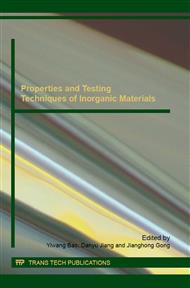p.124
p.129
p.133
p.137
p.141
p.147
p.152
p.158
p.163
Crystal Growth and Fracture Behavior of Solidified TiC-TiB2 Prepared by Combustion Synthesis in High-Gravity Field
Abstract:
Based on the technology of combustion synthesis in high-gravity field, the TiC-TiB2 ceramics with refined microstructures have been fabricated by adjusting the technological parameter and proportioning of raw starting powders. The effects of particle size of raw powders on crystal growth and mechanical properties were studied in this paper. It found that the propagation rate and the combustion temperature can be improved by decreasing the grain size of raw powders, as well as the heat exchange and mass diffusion were enhanced too, so that the microstructure homogenization, densification and mechanical properties of the TiC-TiB2 ceramics were improved accordingly. The highest density, relative density, Vickers hardness and fracture toughness of TiC-TiB2 composites measured 4.07 g/cm3, 87.5%, 22.5 ± 1.2 GPa and 9.5 ± 0.8 MPa·m0.5, respectively, since that the fine B4C powder with particle size < 3.5 µm and the fine Ti powder with particle size < 38 µm were chosed as raw starting powders. The fracture behaviour of TiC-TiB2 composites was dominated by the strong coupled toughening mechanisms of crack deflection and crack-bridging, and the high fracture toughness of the TiC-TiB2 ceramics benefits mainly from the achievement of micro-nanocrystalline microstructure in the full-density solidified ceramic.
Info:
Periodical:
Pages:
141-146
Citation:
Online since:
February 2016
Authors:
Keywords:
Price:
Сopyright:
© 2016 Trans Tech Publications Ltd. All Rights Reserved
Share:
Citation:


